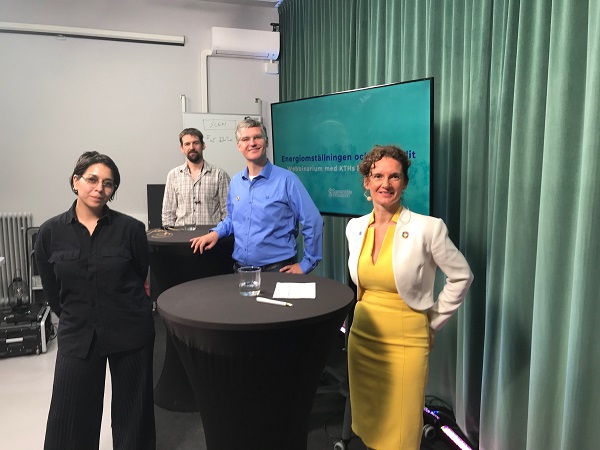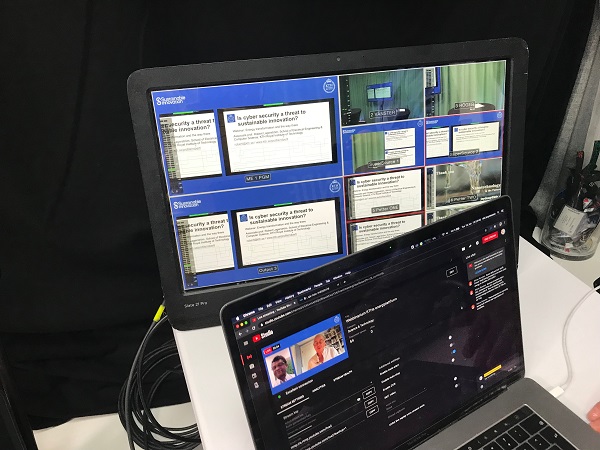New research findings accelerate energy transition
– knowledge-driven change paves the way to sustainable energy systems

Where can we find the most effective innovations in renewable energy? How can we quickly take the step from research to large-scale implementation? KTH’s Energy Platform brought together some 70 participants for a live webinar to strengthen dialogue and co-operation in the energy sector.
On June 16th, Energy Platform and Sustainable Innovation organised the webinar entitled “Energy Transition and the Way There”. During the session, research findings were presented and a panel discussion was held on the challenges related to the ongoing transition of energy systems.
The live broadcast was moderated by Willy Silberstein. The seminar attracted some 70 participants from academia, industry, and the public sector. Participants contributed online with their own input on the energy system’s key challenges.
Participants were welcomed by Lina Bertling Tjernberg, Energy Platform director, and deputy director Christophe Duwig. Both stressed the aim of Energy Platform’s work: to contribute to the development of technologies and approaches that make it possible to achieve the UN’s global climate goals.
Energy Platform focuses on research and development of everything from technology to behavioural transformation, and ongoing societal development.

Key innovations in renewable energy
The knowledge-rich hour was kicked off by Frauke Urban, associate professor and director of the Department of Industrial Economics and Organization (INDEK). Urban referred to a study about the latest international innovations in wind, solar, and hydro power.
The study showed how the most significant technological advances in wind energy had been made in the EU, especially in countries such as Denmark and Germany, and the US and China. European companies hold the most patent registrations related to wind energy.
Technological developments point to increasingly large wind turbines, with growing numbers of wind farms being located at sea. Capacity is increasing as the size of wind farms grows. There are currently facilities under development capable of generating 13-15MW.
In solar energy, innovation is most intense in Asian countries such as China and South Korea, followed by the US and the EU. The leading suppliers in the sector are Chinese, which have also made the majority of patent applications. Standard solar panel technology is being further developed, although work is also being done to improve gallium arsenide cells, thin-film cells, and dye-sensitized solar cells.
Urban showed how the capacity of newly developed solar cells has increased dramatically in recent years, in some cases by as much as 50 per cent.
In hydro power, leading innovators include countries such as the US, Canada, and the EU, with Norway and Sweden being in the forefront. Leading countries in the sector are Chinese, Canadian, Norwegian and Swedish. Innovation trends in hydro power include larger power stations and dams, although there is a certain amount of innovation being conducted in smaller hydro power plants. Fastest growth markets are in Asia, Africa, and Latin America.
Renewable energy cheaper than coal
Renewable energy costs are falling fast. This trend is especially marked for new solar energy technologies. Half of renewable energy sources are now cheaper than new coal-fired power stations, Urban explained.
The study showed that Europe still has an international lead in the sector, although competition from China is becoming increasingly fierce. Sweden has a strong tradition of innovation in hydro power, biomass, and nuclear. But to realise its goal of being 100 per cent renewable by 2040, Sweden will have to see a substantial increase in renewable energy use, along with additional support for innovation especially in wind and solar energy.
The seminar’s second presentation was delivered by Joydeep Dutta, professor in functional materials, who talked about the current considerable international interest in hydrogen as a future fuel source.
Examples include Australia, which is planning to replace its substantial exports of fossil fuels with hydrogen, and Japan where considerable investment is being made in hydrogen-fuelled vehicles. And in Norway, new solutions are planned in conjunction with renewed investment in hydro power to reduce the country’s carbon emissions.
Acute need for hydrogen production
There is considerable need for new ways of producing hydrogen. And the solution that Dutta prefers is recovering hydrogen from water with the help of new functional nanomaterials.
Splitting water molecules to produce hydrogen has always been considered a “holy grail” in the energy field. But it is a grail that will be available within a decade, Dutta said.
However, the cost of producing hydrogen from water remains prohibitively high, therefore more research and development is required. At KTH, among other projects, new catalysts for hydrogen production are being developed. The idea is to combine water purification technologies with hydrogen production, in collaboration with Stockholm Water. Projects exploring the possibility of driving production entirely using sunlight are also being conducted.
Cyber security key to the energy sector
New digital solutions will be key to achieving the UN Sustainable Development Goals, said Robert Lagerström, associate professor at the Department of Network and Systems Engineering at KTH. He gave the day's third presentation, in which he provided insights into the need for improvements in cyber security in the energy field.
The development of new digital solutions brings with it increasingly complex software and systems. In and of itself this trend increases system vulnerability. The path to safer systems, therefore, is through greater knowledge to deal with increasing complexity, Lagerström said.
Although it is not possible to develop an entirely secure system, it is possible to prevent attacks, he said. Researchers have developed models to test and simulate threats and attacks, even on our energy systems. Simulations provide an insight into what measures can provide the best results in terms of reducing a system’s vulnerability.
Safety needs to be prioritised from the early stages of the development of new systems, preferably from the design phase. Systems also need to be developed with a focus on users - as they are often a weak link.
Elevated security awareness in the sector
Lagerström believed that security awareness was high in the energy sector, but that constant improvement is required to keep pace with attackers
This is where co-operation between business and academia is key, along with an understanding of the difference between normal IT systems and core systems.
The seminar concluded with a panel discussion. In addition to Energy Platform’s director, Olga Kordas, researcher and director of the Viable Cities programme, participated, as well as Mikael Östling, professor of micro- and nanotechnology and KTH Deputy President, with special responsibility for infrastructure.
The panel began with a discussion on what is needed to facilitate the jump from research to product and further implementation.
Strong support for innovation at KTH
It is not difficult to take the step from research to product, even if focus is required, Östling said, pointing to the support that exists within KTH Innovation. Here, 300 new ideas are analyzed each year, many in energy efficiency and generation.
Kordas agreed that the time taken to move from research to product is getting shorter. But said that the major challenge is still the step from a working technology to large-scale implementation. Today, there are many examples of smaller pilot initiatives, but significantly fewer of large-scale implementation required for us to become climate neutral.
More collaboration between researchers and other community actors is needed, among other things to eliminate regulatory and lock-in effects. But also to allow for more robust financing of larger investments. Today’s funding is too fragmented, which is detrimental to both development and research.
Lina Bertling Tjernberg highlighted the challenge of working long-term with the development of energy systems infrastructure. To make the important and long-term decisions necessary, we need to develop collaboration between different actors. This is especially true of actors who are unaccustomed to co-operation in the energy field, such as land and property owners.
Research also needs the ability to develop at several levels simultaneously. One example is the ongoing large-scale production of lithium-ion batteries, which is taking place at the same time as research on completely new battery materials.
Simulations may accelerate progress
If the energy sector is to be climate-neutral, change needs to be much faster than is currently the case, Christophe Duwig said. And to get there, we need more widespread use of simulations in virtual environments. Good simulation models can accelerate both development and innovation.
A revolution is needed in the energy field for us to cope with the climate change,” said Duwig, who was optimistic about progress.
Östling highlighted the ongoing sustainability discussion being held with KTH collaboration partners, with whom a consensus is being forged about what is needed, including the development of an infrastructure that can simultaneously handle power shortages and the development of products with ever-less energy consumption.
The research community has a key role to play
Establishing the foundations of stronger collaboration requires will and trust, stressed Bertling Tjernberg. We need to distinguish between opinions and facts more effectively than we do today. Knowledge is power, she said, not least as large and far-reaching decisions regarding our energy supply will be made in the near future. This is where the research community has an important role in providing facts on which to base these decisions.
Kordas highlighted the need for a common language and understanding of each other’s different worlds. And went on to emphasize the need to leave today's small test-based activities in favour of larger system demonstrators where it is possible to develop technologies, regulations, and financing models in collaboration with others. Today, we must focus on the transformative system changes that are required to succeed in realizing the transition to a climate-neutral and fossil-free society, Kordas said.
Bertling Tjernberg also emphasized how Sweden must be better at seeing itself as part of the rest of the world. The close control of research must take a back seat to the freedom necessary to see the needs of the outside world and to work long term to solve new challenges.
Wrapping up the session, Bertling Tjernberg called for continued active dialogue. The energy issue is consistently relevant and the trust and understanding that active discussions create is vital.
Watch the full seminar here .
Don’t forget this year’s edition of KTH Energy Dialogue, which will be launched at Tekniska museet in Stockholm on the 19th of November.
Text: Magnus Trogen Pahlén

